The Toshiba TR200 3D NAND SSD Review: One Step Forward, One Step Back
by Billy Tallis on October 11, 2017 7:00 AM ESTAnandTech Storage Bench - The Destroyer
The Destroyer is an extremely long test replicating the access patterns of very IO-intensive desktop usage. A detailed breakdown can be found in this article. Like real-world usage, the drives do get the occasional break that allows for some background garbage collection and flushing caches, but those idle times are limited to 25ms so that it doesn't take all week to run the test. These AnandTech Storage Bench (ATSB) tests do not involve running the actual applications that generated the workloads, so the scores are relatively insensitive to changes in CPU performance and RAM from our new testbed, but the jump to a newer version of Windows and the newer storage drivers can have an impact.
We quantify performance on this test by reporting the drive's average data throughput, the average latency of the I/O operations, and the total energy used by the drive over the course of the test.

The Toshiba TR200 starts off in last place. At every capacity, the TR200's average data rate on The Destroyer is slower than the competition, including the HP S700, the only other DRAMless TLC SSD we've tested recently. The largest and fastest TR200 is as slow as the smallest model of its predecessor TR150.
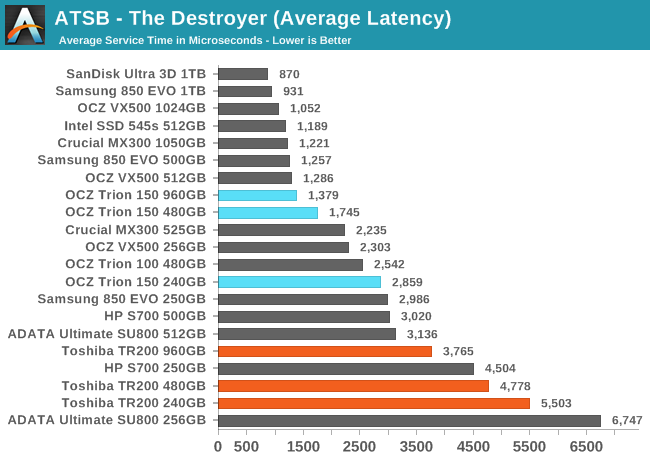
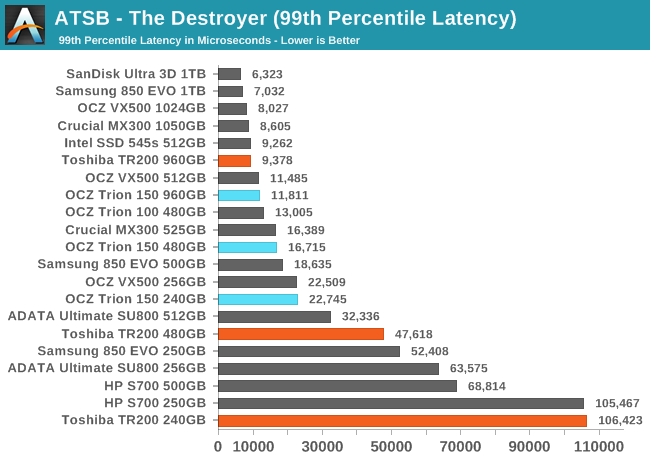
The average latency from the TR200s is high for all three capacities, but only the larger two capacities are showing record high latencies for their size class. The 99th percentile latencies aren't quite as bad, especially with the larger capacities: the 960GB TR200 does a good job of keeping latency under control, the 480GB falls roughly in between the HP S700 and the rest of its competition, and the 240GB TR200 is tied with the HP S700 for last place.

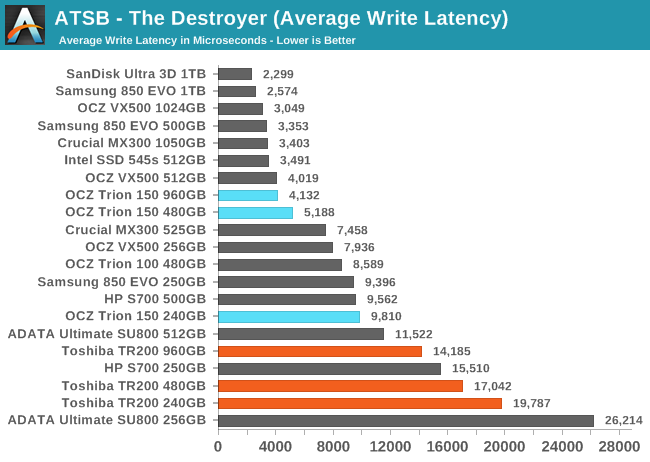
Average read and write latencies are both high for the TR200, and much higher than with the predecessor TR150. It's unusual to see this much latency in the larger capacities, but the 240GB TR200 isn't an egregious outlier on these metrics.
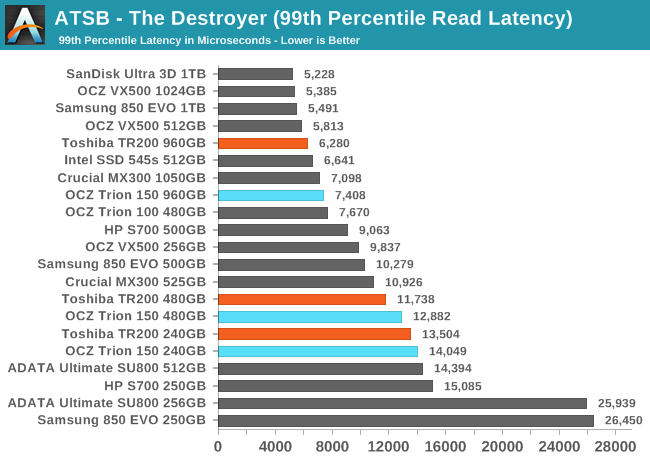
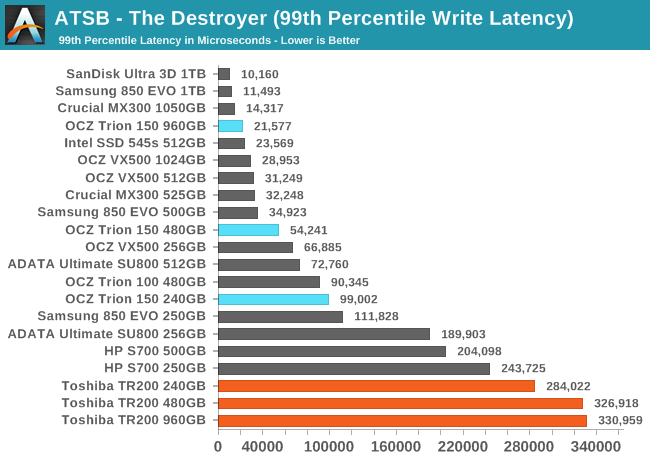
The 99th percentile read latency of the TR200 is a small but clear improvement over the TR150, and the 960GB TR200 scores pretty well overall. On write operations, all capacities of the TR200 have poor QoS, with 99th percentile write latencies between a quarter and a third of a second. It's clear that the TR200 (and to a lesser extent the HP S700) suffer quite a bit from the lack of DRAM when the drive needs to perform garbage collection in parallel with handling new write operations.

Despite quite poor performance, the Toshiba TR200 returns decent energy usage results. The 960GB TR200 just barely sets a new record for lowest energy usage on The Destroyer, despite taking significantly longer to complete the test than its competition. Even the 240GB TR200 was much more efficient overall than all previous Trion/TR series drives, and used a third less energy than the 256GB ADATA SU800 (which was 27% faster).










50 Comments
View All Comments
r3loaded - Wednesday, October 11, 2017 - link
Pwned by an 850 Evo but only $10 cheaper. Yay what a surprise.ddriver - Wednesday, October 11, 2017 - link
Cudos to toshiba for making an ssd that is as slow in sequential writes as a mechanical hdd. I can't imagine it was easy.It's a serious contender for "lousiest sata ssd of 2017".
masouth - Wednesday, October 11, 2017 - link
of just 2017?takeshi7 - Wednesday, October 11, 2017 - link
correction: slower than an hdd in sequential writes. But then again a lot of these cheap TLC drives have lower sustained write speed than HDDs. What really amazes me is that Toshiba actually made an SSD that's worse than the Crucial BX200. I never thought that would be possible.Samus - Wednesday, October 11, 2017 - link
At 1/10th the power consumption though. As hard as it is to defend this drive, it’s clear toshiba had a very specific goal in mind with this drive: cheap upgrades for cheap laptops. As an OEM supplier for many vendors (including even Apple) this drive is adequate for many sub-$500 laptops: being dramless makes power loss protection mostly unnecessary as it will likely recover from sram loss inside the controller, as the indirection table is mirrored off then back to the nand after each write.However, I’ve never been a fan of dramless controllers. Seams like a mind boggling corner to cut when the cost of 512mb DDR3 is $4.
Lolimaster - Wednesday, October 11, 2017 - link
Fact is Crucial MX300 is as cheap and way better, my way way way better,Samus - Sunday, October 15, 2017 - link
I've long stood by that assertion. Crucial and Samsung SSD's are the only mainstream drives worth considering. Sure, Sandisk, Intel, even Mushkin have their niche products, but Samsung and Crucial have no real "duds."Flunk - Wednesday, October 11, 2017 - link
Has Anandtech reviewed another budget SSD that's competitive with the 850 Evo, seems like that's the gold standard at the moment. I just bought one for my Mom for Christmas.theramenman - Wednesday, October 11, 2017 - link
The SanDisk Ultra 3D they reviewed a bit ago gets similar performance to a 850 Evo for $43 less (at least for the 1TB version).sonny73n - Thursday, October 12, 2017 - link
3 most valued SSD models currently on Amazon. One of them is the BX300 with capacity max out at 480GB which I can only compare it to the similar of the other 2.- Samsung 850 Evo 500GB $160
- SanDisk Ultra 3D 500GB $170
- Crucial BX300 480GB $145
The first 2 are made of TLC NAND and the BX300 is made of MLC. No brainer to pick the best one here.